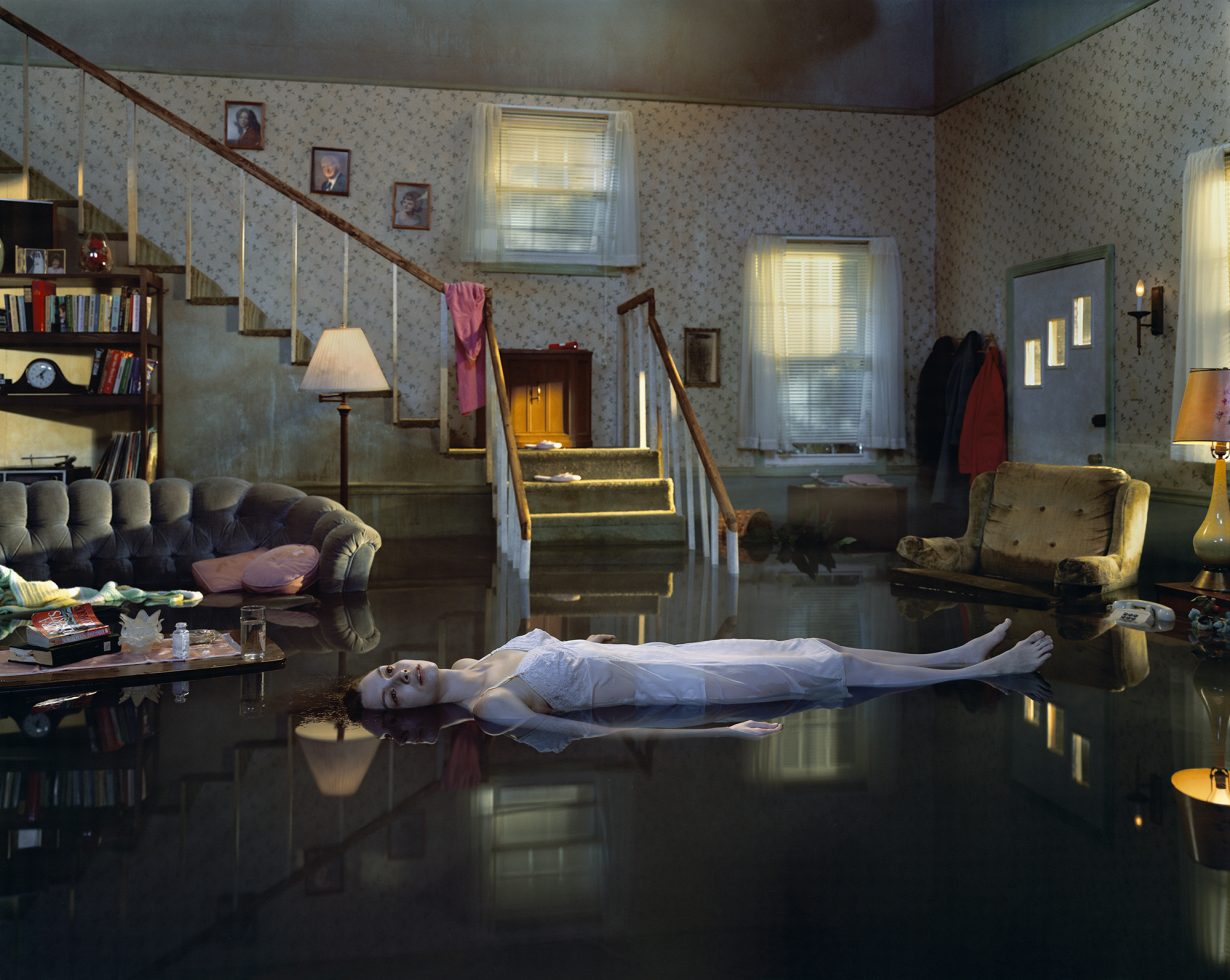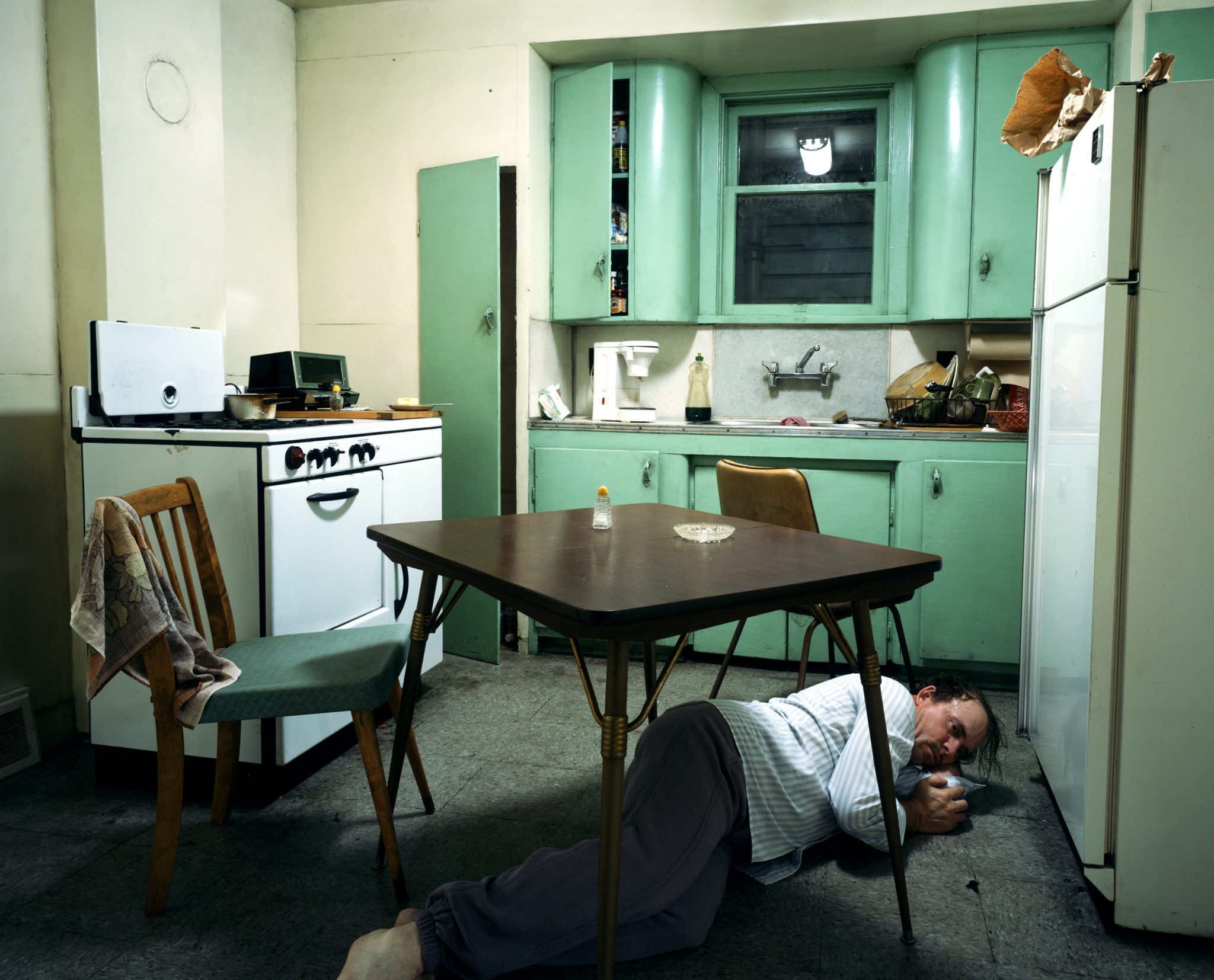Despite the form’s modest resurgence – evidenced by Jeff Wall’s exhibition at White Cube London – its politics remain troubling
It was while sitting in the waiting area of a now-closed branch of NatWest bank in Wembley Park that I discovered the works of Canadian photography pioneer Jeff Wall. I was reading Charlotte Cotton’s The Photograph as Contemporary Art (2004). Images such as Insomnia (1994) are hard to forget, distressing and impressing in equal measure: a man lies down on a kitchen floor in a quasi-foetal position in the dead of night, slumped underneath a dining table, the kitchen’s imposing teal cabinets illuminated by a stark overhead light. It’s a definitive image within Wall’s oeuvre: one with which to begin examining his work, while also questioning what exactly a photograph can, or should, be.
With an exhibition of Wall’s work at London’s White Cube, marking 30 years of the artist and gallery working together, it’s worth reflecting on the place of staged, or tableau photography within the context of contemporary art. Despite its popularity between the 1980s and 2000s by way of artists such as Cindy Sherman, Justine Kurland, Sam Taylor Johnson, Sarah Dobai and Wall himself, and with a modest resurgence in the last decade – the stylistic approach has largely remained in the shadow of styles rooted in documentary traditions. In an age where the success of an image is dependent on its immediate ability to compel, entertain, and its capacity to be shared (all the while being subjected to algorithms and now, in some cases, AI), it seems about time to question the relevance of a photographic genre anchored to imitation and designed for the archaic confines of the gallery wall.
Despite my reverence for the genre, its flaws are not lost on me. Tableau photography gratuitously deceives by way of an already dishonest medium, mocking the famed ‘decisive moment’ – the visual climax of an observed scene’s action – in the name of creative expression. Grandiosely preconceived images – products of cable-shutter releases, ambitious lighting, makeup artists and location scouts – seek to imitate what is earned by the mastery of documentarians. They are conveniently conjured images, by way of mood boards, popular culture references, sociopolitical stances and ideologies – the list goes on. It would be reasonable to call them faddish, overly sentimental, aesthetic-heavy, and far too often they siphon hackneyed traits from art history movements (Impressionism and the Pre-Raphaelites to name but two). You only have to look to the use of Millais’s Ophelia (1851–52) as a reference for British artist Tom Hunter’s The Way Home (2000) alongside American Gregory Crewdson’s Untitled (2001) to eyeroll at the narrowness of source material; or, seeing Hannah Starkey’s Untitled – May 1997 images alongside Jeff Wall’s Picture for Women (both 1997), to cringe at the outdated use of mirrors as plot devices, or female vanity as entertainment, in spite of their modern, subversive intentions. This doesn’t even consider the genre’s reliance on the gallery to accommodate the sheer scale of these stylistically typical images, printed at colossal dimensions simply to make the otherwise mundane seem like a remotely remarkable spectacle. When compared with other genres such as fashion, portraiture, documentary or still-life – genres primed for the digital age, occasionally derivative in their own respects, but easily digestible and arresting in their directness and ability to entertain – the tableau image can often feel rightfully ready to be consigned to the history books.

Yet the genre’s redeeming qualities outweigh its shortcomings. It permits artists to give pause, offering a contemplative space beyond the constraints of the fleeting snapshot, in which the nature of ideas and aesthetics can be explored without the fanfare, frills or formality of other genres. Within the tableau image, the subject needn’t confront the camera; the artist needn’t frantically snap away, in the hope of capturing the one. Consider Deutsche Börse recipient Mohamed Bourouissa’s Périphérique series (2005–08) for example, in which the artist portrays his suburban Parisian community – loitering, conversing, passing time – in compositions reminiscent of history paintings but set in housing estates, thus presenting an alternative narrative of marginalised people through visual codes usually reserved for bourgeois, high-brow art; or Yinka Shonibare’s five compositions in Diary of a Victorian Dandy (1998), in which the boundaries of history, race and privilege are blurred by way of a fictionalised character, challenging the place of blackness within Victorian society. In using the tableau image to navigate complex, divisive and often uncomfortable issues, an artist beholds the image’s potential to mimic, instil change, educate, and to challenge the parameters set in the objective world; to reimagine and rewrite, with modern takes on the genre by British artist Juno Calypso and Norwegian Tobjorn Rødland doing just that.
“If it survives, it’ll be because people want it to,” said Wall, when I asked him back in 2020 about the future of his genre, and given the increasing renewed interest, he may just be right. At its core, the tableau image – one ever-adapting and still enthralling – is one whose popularity may ebb and flow, but whose tenacity, appeal and boundless potential has earned its right to as much respect as its contemporaries.
Dorrell Merritt is an artist, writer and publisher based in London
From the November 2024 issue of ArtReview – get your copy.
